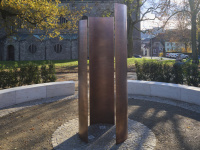
Gedenkort Nachhall Echelmeyerpark - Tom Gudelwein
Gedenkort Nachhall Echelmeyerpark - Tom Gudelwein
Gedenkort Nachhall Echelmeyerpark - Tom Gudelwein
Gedenkort Nachhall Echelmeyerpark - Tom Gudelwein
In memory of the Sinti and Roma who lived in the former Saar Territory and who were persecuted and murdered during the National Socialist era. Sinti and Roma migrated from north-west India to western and eastern Europe over 1000 years ago. To this day, the total number of Sinti and Roma murdered during the National Socialist regime can only be approximated. Based on cautious estimates, which are mostly based on statistical data from the National Socialist era, it can be assumed that up to 500,000 Roma and Sinti were murdered.
The social and state discrimination against Sinti and Roma did not end in 1945. For a long time, they were denied recognition that they had been victims of racist National Socialist persecution. The Council of Europe first drew attention to the injustice suffered by the Sinti and Roma in 1969.
In 1982, when the then German Chancellor Helmut Schmidt lamented the racist persecution of the Sinti and Roma and spoke of genocide, a change in social awareness of National Socialist racism became apparent. This was particularly preceded by the work of Romani Rose, who became chairman of the Central Council of German Sinti and Roma, which he co-founded, in 1982.
The persecution of Sinti and Roma in the former Saar Territory during the National Socialist tyranny has not yet been comprehensively researched. Nevertheless, the persecution is documented, as evidenced by the files of the State Compensation Office in the Saarland State Archives, but its analysis is laborious.
The memorial site in Saarbrücken is located in the immediate vicinity of St. Michael's Catholic Church, where Father Arnold Fortuin served as chaplain from 1927 to 1933. He later gained nationwide recognition as a pastoral caregiver to the Sinti and Roma.
Father Arnold Fortuin cared for Sinti and Roma families in the Saarbrücken parish and, in 1932, secretly founded a school for their children in the presbytery, together with Franz Lehmann Kimeling, a Sinto friend of his. During the National Socialist era, many Sinti and Roma, under threat of persecution and murder, turned to him for help in fleeing abroad. After the Second World War, Father Arnold Fortuin assisted with the compensation claims of the Sinti and Roma and was appointed National Director of 'Catholic Pastoral Care for Roma, Sinti, and Related Groups' by the German Bishops' Conference from 1965 to 1970.
Embedded in the green areas of Echelmeyerpark, the state capital of Saarbrücken offers an artistically designed memorial to the persecuted and murdered Sinti and Roma, a place of reflection and living remembrance.
The memorial site consists of various elements and media that all point to the common centre and encircle an imaginary void. The sculptural and interactive memorial is located in the centre of a circular square. Three radially shaped bronze segments of different sizes surround the joint centre. The design symbolises the loss suffered - the loss of each individual loved one, their voices and the shared cultural identity.
Sound fragments of Sinti and Roma culture can be accessec from the centre, from the floor area between the bronze segments, using audio QR codes on a smartphone and transmitted to the memorial site. An atmospheric sound space of bowed chordal sounds is created, which flow, combine and condense into one another.
Three stone segmental arches and a half-height green hedge define a meeting place akin to spreading sound waves. Ornamental grasses, seasonal flowers and bands of paving form further circles in the park.
This site was realised at the initiative of the Saarland State Association of German Sinti & Roma. The memorial entitled ‘Nachhall’ (Resonance) was designed and realised by Saarbrücken sculptor and sound artist Frauke Eckhardt on behalf of the Cultural Office in collaboration with the art commission of the state capital of Saarbrücken.
Echelmeyerpark
Schumannstraße